Cinchona or Quinine
Tree
Cinchona is a genus of about 25
species in the family Rubiaceae, native to tropical
South America. They are large
shrubs or small trees growing to 5-15 metres tall with
evergreen foliage. The
leaves are opposite, rounded to lanceolate, 10-40
cms long. The flowers are white, pink or
red, produced in terminal panicles. The fruit is a small capsule containing numerous seeds. South American Indians have been using cinchona bark
to treat fevers for many centuries. Spanish conquerors learned of quinine's
medicinal uses in Peru, at the beginning of the 17th Century. Use of the
powdered " Peruvian bark" was first recorded in religious writings by the
Jesuits in 1633. The Jesuit fathers were the primary exporters and importers of
quinine during this time and the bark became known as " Jesuit bark.". The use
of quinine for fevers was included in medical literature in 1643.
Stories of the medicinal properties of this bark, however, are perhaps
noted in journals as far back as the 1560’s-1570’s. We saw many of these trees
on our 'pram' ride through the rain forest.
Cinchona species are used as food plants by the
larvae of some Lepidoptera species including The Engrailed, The
Commander, and members of the genus
Endoclita including E.
Damor, E. Purpurescens and E. Sericeus.
Cinchona alkaloids
The bark of trees in this genus is the source of a variety of
20 alkaloids , the most familiar of which is
quinine, an anti-fever agent especially useful in treating
malaria. Cinchona alkaloids include:
cinchonine and
cinchonidine
(stereoisomers with R = vinyl, R' =
hydrogen), quinine and quinidine (stereoisomers with R = vinyl, R' = methoxy), dihydroquinidine & dihydroquinine (stereoisomers with R = ethyl, R' = methoxy). They find use in organic
chemistry as
organocatalysts in asymmetric
synthesis.
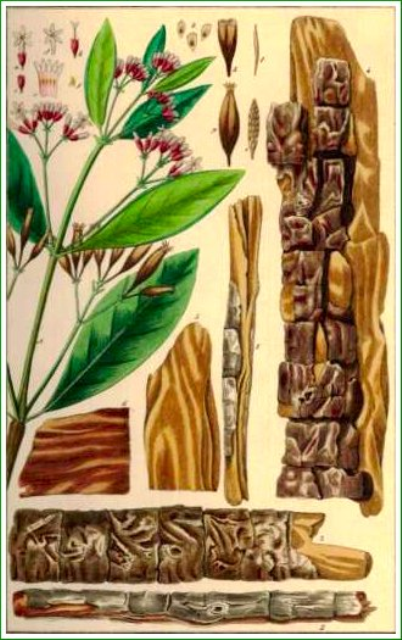
History
The Italian botanist Pietro Castelli wrote a pamphlet noteworthy as being the first Italian
publication that mentions the cinchona. By the 1630's (or 1640's, depending on
the reference), the bark was being exported to Europe. In the late 1640's, the
method of use of the bark was noted in the Schedula Romana, and in 1677
the use of the bark was noted in the London Pharmacopoeia. According to legend,
the first European ever to be cured from malaria fever was the wife of the
Spanish Viceroy, the countess of Chinchon. The
court physician was summoned and urged to save the countess from the waves of
fever and chill that were threatening her life, but every effort failed to
relieve her. At last the physician administered some medicine which he had
obtained from the local Indians, who had been using it for similar syndromes.
The countess survived the malarial attack and reportedly brought the cinchona
bark back with her when she returned to Europe in the 1640s. The story of her
cure is doubtful. Charles II called upon Mr Robert Talbor, who had become
famous for his miraculous malaria cure. Because at that time the bark was in
religious controversy, Talbor gave the king the bitter bark decoction in great
secrecy. The treatment gave the king complete relief from the malaria fever. In
return, he was offered membership of the prestigious Royal College of
Physicians. In 1679 Talbor was called by the King of France, Louis
XIV, whose son was suffering from malaria fever. After a successful
treatment, Talbor was rewarded by the king with 3,000 gold crowns. At the same
time he was given a lifetime pension for this prescription. Talbor, however, was
asked to keep the entire episode secret. After the death of Talbor, the French
king found this formula: six drams of rose leaves, two ounces of lemon juice and
a strong decoction of the chinchona bark served with wine. Wine was used because
some alkaloids of the cinchona bark are not soluble in water, but are soluble in
wine.
The birth of homeopathy was based on
quinine testing. The founder of homeopathy, Dr. Samuel
Hahnemann, when translating the Cullen's
Materia Medica, noticed that Dr
Cullen wrote that quinine cures malaria and can
also produce malaria. Dr. Hahnemann took daily a large non-homeopathic dose of
quinine bark. After two weeks, he said he felt malaria-like symptoms. This idea
of "like cures like" was the starting point of his writings on "Homeopathy". In
1738, Sur l'arbre du quinquina, a paper written by Charles Marie de La
Condamine, a member of the
expedition that was sent to
Peru to determine the length of a degree of the
meridian in the neighbourhood of the
equator, was published by the French Academy of
Sciencies. In it he identified three
separate species. In 1742, on the basis of a specimen received from La
Condamine, Linnaeus named the tree Quinquina condaminiae and established a new
genus, which he termed Cinchona quinquina condaminiae. In 1753 he described
Cinchona officinalis as a separate species.
History of cultivation
The bark was very valuable to Europeans in expanding their
access to and exploitation of resources in far off colonies, and at home. Bark
gathering was often environmentally destructive, destroying huge expanses of
trees for their bark, with difficult conditions for low wages that did not allow
the indigenous bark gatherers to settle debts even upon death. In 1860, a
British expedition to South America led by Clements
Markham brought back Cinchona seeds and plants,
which were planted in the Hakgala Botanical Garden in Sri Lanka in January 1861. James Taylor, the pioneer of tea planting in Sri Lanka, was one of
the pioneers of Cinchona cultivation. By 1883 about 64,000 acres (260
km2) were in cultivation in Sri Lanka, with exports reaching a peak
of 15 million pounds in 1886. In 1865, the "Carlota Colony" was founded in
Mexico. Wealthy American post-war confederate leaders were enticed there by the
Emporer Maximillian, Archduke of Habsburg. The colony was situated on the direct
Mexico-Vera Cruz Highway, and within 50 km. of the railway, which was due to
arrive in Cordoba at the end of that year. ... "All that survives today of the
ill-fated Carlota Colony are the flourishing groves of cinchonas, the
quinine-producing tree which ... at Empress Charlotte's instigation, were first
introduced into the country."
Treatments
Cinchona has been used for a number of medical reasons such as: Treats
malaria (until the development of synthetic drugs, quinine was used as the
primary treatment of malaria, a disease that kills over 100 million people a
year). Kills parasites. Reduces fever. Regulates heartbeat. Calms nerves.
Stimulates digestion. Kills germs. Reduces spasms. Kills insects. Relieves pain.
Kills bacteria and fungi. Dries secretions. Natures own Viagra. The main reason
for its use is to treat malaria, but it is rarely used today as many people
think it is dangerous, as it can kill if taken in large amounts. Quinidine is
used to treat cardiac arrhythmias.
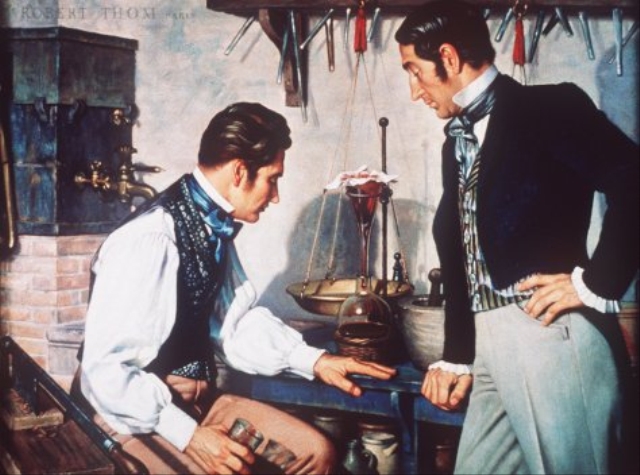
Quinine
Quinine did not gain wide acceptance in the medical community
until Charles II was cured of the ague by a London apothecary at the end
of the 17th century. Quinine was officially recognized in an edition of the
London Pharmacopoeia as "Cortex Peruanus" in 1677. Thus began the quest for
quinine. In 1735, Joseph de Jussieu, a French botanist, accompanied the first
non-Spanish expedition to South America and collected detailed information about
the cinchona trees. Unfortunately, as Jussieu was preparing to return to France,
after 30 years of research, someone stole all his work. Charles Marie de la
Condamine, leader of Jussieu's expedition, tried unsuccessfully to transfer
seedlings to Europe. Information about the cinchona tree and its medicinal bark
was slow to reach Europe. Scientific studies about quinine were first published
by Alexander von Humboldt and Aimé Bonpland in the first part of the 18th
century. The quinine alkaloid was separated from the powdered bark and named
"quinine" in 1820 by two French doctors. The name quinine comes from the
Amerindian word for the cinchona tree, quinaquina, which means "bark of barks."
As European countries continued extensive colonization in Africa, India and
South America, the need for quinine was great, because of malaria. The Dutch and
British cultivated cinchona trees in their East Indian colonies but the quinine
content was very low in those species. A British collector, Charles Ledger,
obtained some seeds of a relatively potent Bolivian species, Cinchona
ledgeriana. England, reluctant to purchase more trees that were possibly low
in quinine content, refused to buy the seeds. The Dutch bought the seeds from
Ledger, planted them in Java, and came to monopolize the world's supply of
quinine for close to 100 years. During World War II, the Japanese took control
of Java. The Dutch took seeds out of Java but had no time to grow new trees to
supply troops stationed in the tropics with quinine. The United States sent a
group of botanists to Columbia to obtain enough quinine to use throughout the
war. In 1944, synthetic quinine was developed by American scientists. Synthetic
quinine proved to be very effective against malaria and had fewer side effects,
and the need for natural quinine subsided. Over the years, the causative
malarial parasite became resistant to synthetic quinine preparations.
Interestingly, the parasites have not developed a full resistance to natural
quinine.
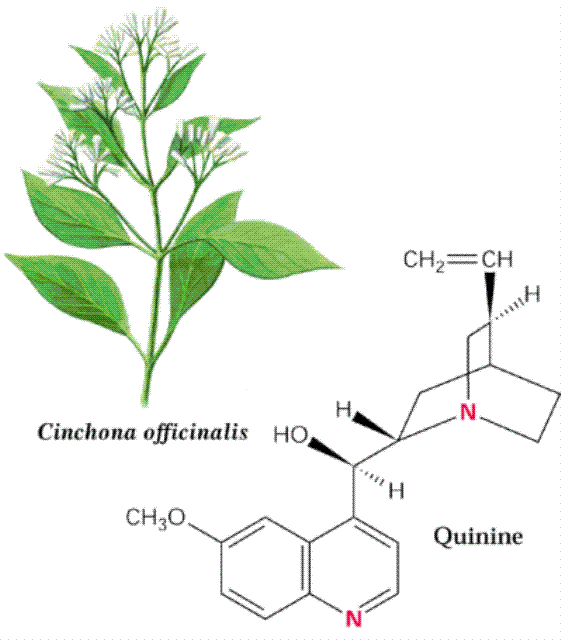
The chemical composition of quinine is
C20H24N2O2.H2O.
Quinine is derived from cinchona bark, and mixed with lime. The bark and lime
mixture is extracted with hot paraffin oil, filtered, and shaken with sulphuric
acid. This solution is neutralized with sodium carbonate. As the solution cools,
quinine sulphate crystallizes out. To obtain pure quinine, the quinine sulphate
is treated with ammonia. Crystalline quinine is a white, extremely bitter
powder. The powdered bark can also be treated with solvents, such as toluene, or
amyl alcohol to extract the quinine. Current biotechnology has developed a
method to produce quinine by culturing plant cells. Grown in test tubes that
contain a special medium that contains absorbent resins, the cells can be
manipulated to release quinine, which is absorbed by the resin and then
extracted. This method has high yields but is extremely expensive and
fragile.
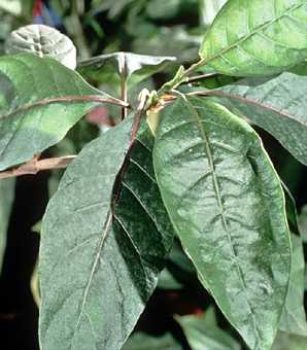 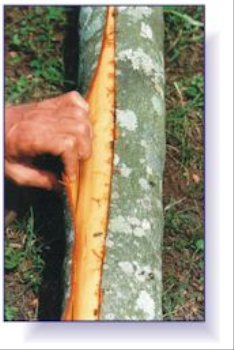 
Medicinally, quinine is best known for its treatment of
malaria. Quinine does not cure the disease, but treats the fever and other
related symptoms. Pharmacologically, quinine is toxic to many bacteria and
one-celled organisms, such as yeast and plasmodia. It also has antipyretic
(fever-reducing), analgesic (pain-relieving), and local anaesthetic properties.
Quinine concentrates in the red blood cells and is thought to interfere with the
protein and glucose synthesis of the malaria parasite. With treatment, the
parasites disappear from the blood stream. Many malarial victims have a
recurrence of the disease because quinine does not kill the parasites living
outside the red blood cells. Eventually, the parasites make their way into the
blood stream, and the victim has a relapse. Quinine is also used to treat
myotonic dystrophy (muscle weakness, usually facial) and muscle cramps
associated with early kidney failure. The toxic side effects of quinine, called
Cinchonism, include dizziness, tinnitus (ringing in ears), vision disturbances,
nausea, and vomiting. Extreme effects of excessive quinine use include blindness
and deafness.
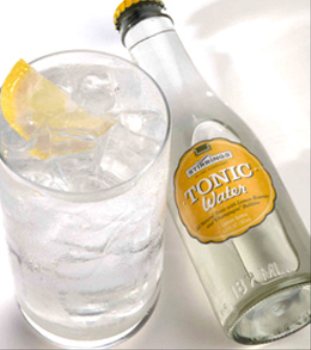
Quinine also has non-medicinal uses, such as in preparations
for the treatment of sunburn. It is also used in liqueurs, bitters, and
condiments. The best known non-medicinal use is its addition to tonic water and
soft drinks. The addition of quinine to water dates from the days of British
rule in India-quinine was added to water as a prevention against malaria. About
40% of the quinine produced is used by the food and drug industry, the rest is
used medicinally. In the United States, beverages made with quinine may contain
not more than 83 parts per million cinchona alkaloids.
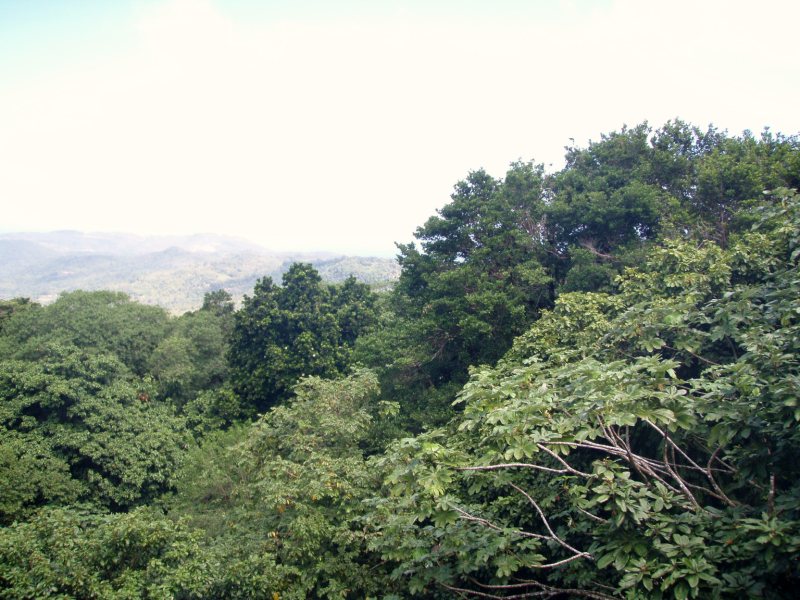
ALL IN ALL a really useful tree.
|








